Change Order Letter
[Your Company's Name]
[Your Company's Address]
[City, State, Zip Code]
[Today's Date]
[Recipient's Name]
[Recipient's Title/Position]
[Recipient's Company]
[Recipient's Address]
[City, State, Zip Code]
Subject: Change Order Request - [Project/Contract Name]
Dear [Recipient's Name],
I hope this letter finds you well. We appreciate your ongoing partnership and collaboration on the [Project/Contract Name].
We are writing to formally request a change order for the aforementioned project/contract. After thorough review and assessment, it has come to our attention that certain modifications and adjustments are necessary to ensure the successful completion of the project and meet the desired objectives.
The details of the proposed change(s) are as follows:
1. Change Description:
- [Provide a detailed description of the requested change(s)]
2. Reason for Change:
- [Explain the reason(s) behind the requested change(s)]
3. Impact on Project Schedule:
- [Indicate any expected time implications, such as delays or accelerated timelines]
4. Impact on Project Budget:
- [Specify the estimated cost implications of the change(s)]
5. Supporting Documentation:
- [Attach any relevant documentation or drawings to support the change request]
We have carefully evaluated the implications of the proposed change(s) on both the project timeline and budget and are confident that implementing these adjustments will enhance the overall outcome and ensure the project's success.
We kindly request your prompt review and approval of this change order request. Upon your approval, we will promptly update all necessary documentation and initiate the required modifications.
If you have any questions or require further information regarding this change order request, please do not hesitate to contact us at [Your Phone Number] or [Your Email Address].
Thank you for your attention to this matter. We look forward to your positive response and continued collaboration.
Sincerely,
[Your Name]
[Your Title/Position]
[Your Company]
[Your Contact Information]
Formal Change Order Letter for Construction Project
Subject: Change Order Request – [Project Name]
Dear [Recipient's Name],
This letter serves as a formal request to implement a change in the scope of work for the [Project Name]. The requested changes include [describe specific changes in detail], which are necessary due to [reason for change].
Please review the attached revised specifications and confirm approval. Additionally, adjustments to the project timeline and budget are proposed as follows: [insert details].
We appreciate your prompt attention to this matter and look forward to your confirmation.
Sincerely,
[Your Name]
[Your Position]
[Company Name]
Provisional Change Order Letter
Subject: Provisional Change Order for [Project Name]
Dear [Recipient's Name],
We request a provisional change order for [Project Name] regarding [specific change]. This change is preliminary and may require further adjustments pending your review.
Kindly provide feedback on feasibility and associated costs so we can proceed with formal approval.
Thank you for your cooperation.
Best regards,
[Your Name]
[Position]
[Company Name]
Quick Email Change Order Request
Subject: Change Order Request – [Project Name]
Hi [Recipient's Name],
Please find attached a proposed change to [Project Name] involving [brief description]. Let me know your thoughts and any required approvals.
Thanks,
[Your Name]
Detailed Change Order Letter with Budget Adjustment
Subject: Request for Change Order – [Project Name]
Dear [Recipient's Name],
I am writing to request a change order for [Project Name]. The requested modifications include [detailed description of changes] due to [reason, e.g., unforeseen circumstances, client request, regulatory requirement].
Attached is the revised budget reflecting these changes, with new costs totaling [insert amount]. We also propose an updated timeline of [new dates] to accommodate these adjustments.
Please review and approve the proposed changes at your earliest convenience.
Sincerely,
[Your Name]
[Your Position]
[Company Name]
Casual Change Order Letter for Internal Team
Subject: Change in [Project Name] Scope
Hi Team,
We need to implement the following changes in [Project Name]: [list changes]. This adjustment is required because [reason].
Please update your schedules and workflows accordingly and confirm when the updates are complete.
Thanks,
[Your Name]
What / Why You Need a Change Order Letter
Purpose of a Change Order Letter
- A Change Order Letter is a formal document requesting modifications to an existing contract or project scope.
- Purpose:
- Communicate changes in work scope, timeline, or budget.
- Ensure legal and contractual compliance.
- Provide a clear record of alterations for accountability.
- Prevent misunderstandings between parties.
Who Should Send a Change Order Letter
Authorized Senders
- Project managers initiating modifications in ongoing projects.
- Contractors or suppliers requesting adjustments in deliveries or specifications.
- Departments or teams responsible for project execution requesting approval for changes.
Whom Should Receive a Change Order Letter
Intended Recipients
- Clients or customers approving project modifications.
- Supervisors, contract administrators, or regulatory authorities.
- Internal stakeholders impacted by scope or timeline changes.
When to Send a Change Order Letter
Timing Scenarios
- When project requirements change due to unforeseen circumstances.
- After client requests additional work or modifications.
- Before implementing budget or schedule adjustments.
- During regulatory or compliance-driven changes in project execution.
How to Write and Send a Change Order Letter
Step-by-Step Process
- Clearly identify the project and original contract or agreement.
- Describe the requested changes in detail, including technical and financial implications.
- Specify reasons for the change and supporting documentation.
- Propose adjustments to timeline, cost, or deliverables.
- Maintain a professional and clear tone.
- Choose mode: email for quick notification, printed letter for official contracts.
Formatting a Change Order Letter
Recommended Style
- Length: concise yet comprehensive; ideally one page.
- Tone: Professional and formal; casual for internal communications.
- Structure: Subject line, greeting, detailed change description, impact on cost and timeline, request for approval, closing.
- Attachments: include revised plans, cost breakdowns, and supporting documents.
- Mode: Email for internal or fast communication, printed letter for contractual or legal purposes.
Tricks and Tips for Effective Change Order Letters
Best Practices
- Use clear, concise, and unambiguous language.
- Include all necessary documentation to support the change.
- Indicate deadlines for approval or response.
- Keep a copy for records to track project alterations.
- Confirm verbal discussions in writing to avoid disputes.
Common Mistakes in Change Order Letters
Pitfalls to Avoid
- Omitting key details about the change or impact.
- Sending letters without prior discussion or context.
- Using vague language that can cause misunderstandings.
- Failing to document approvals and responses.
- Not updating related project schedules or budgets accordingly.
Elements and Structure of a Change Order Letter
Key Components
- Subject line indicating "Change Order Request".
- Salutation addressing the recipient.
- Detailed description of requested changes.
- Reason or justification for the change.
- Impact on budget, timeline, or resources.
- Request for approval or confirmation.
- Closing with signature and contact information.
- Attachments: supporting documents, revised plans, cost estimates.
After Sending a Change Order Letter
Follow-Up Steps
- Track responses and approvals from recipients.
- Update project plans and schedules accordingly.
- Communicate confirmed changes to all stakeholders.
- Keep a record of the letter and any correspondence for contractual purposes.
- Address any discrepancies or concerns promptly.
Pros and Cons of Sending a Change Order Letter
Advantages
- Provides formal documentation for changes.
- Maintains clarity and transparency among stakeholders.
- Ensures contractual and legal compliance.
- Helps manage expectations and timelines.
Disadvantages
- May delay project approval if responses are slow.
- Could increase costs or workload if changes are significant.
- Risk of disputes if not clearly documented or justified.

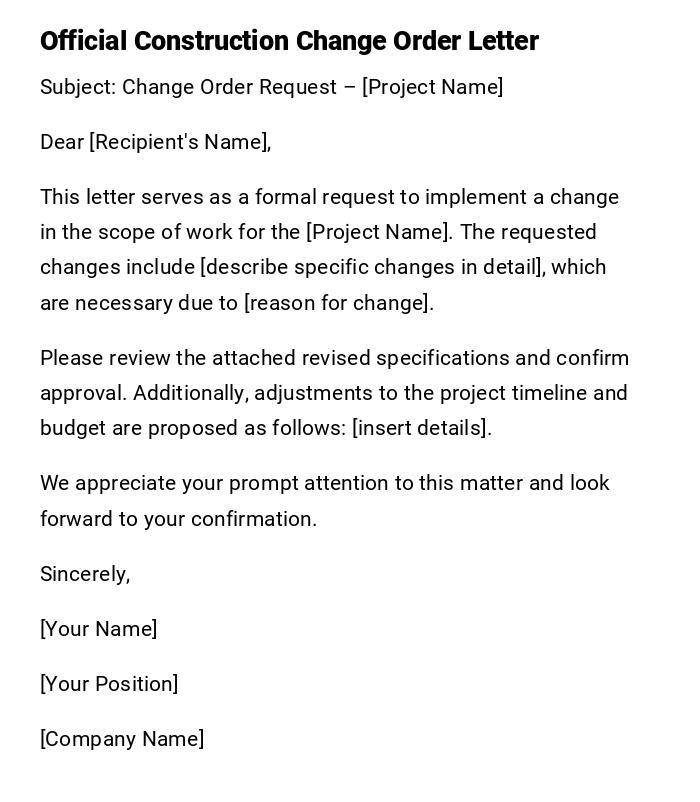
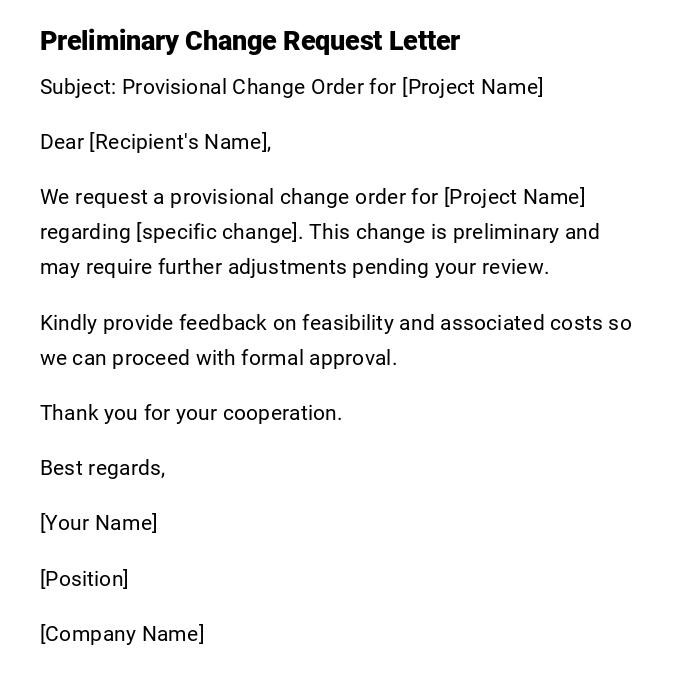
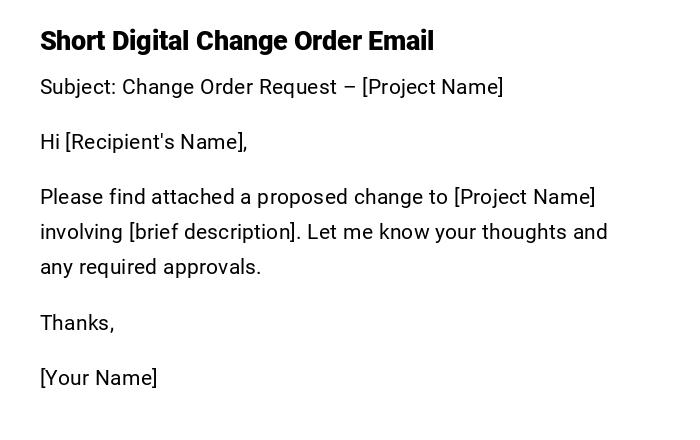
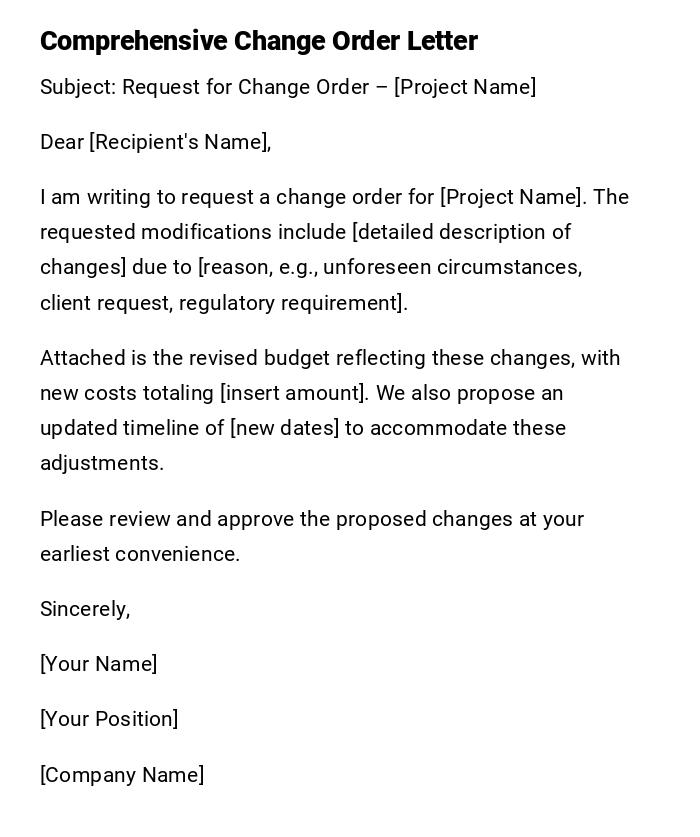
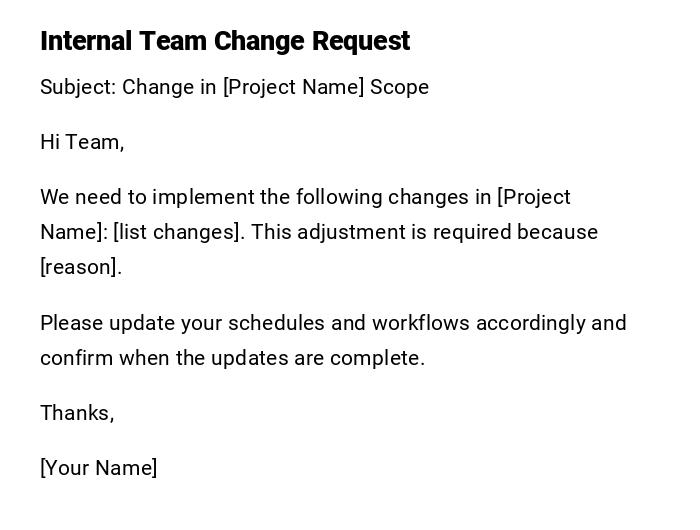

 Download Word Doc
Download Word Doc
 Download PDF
Download PDF